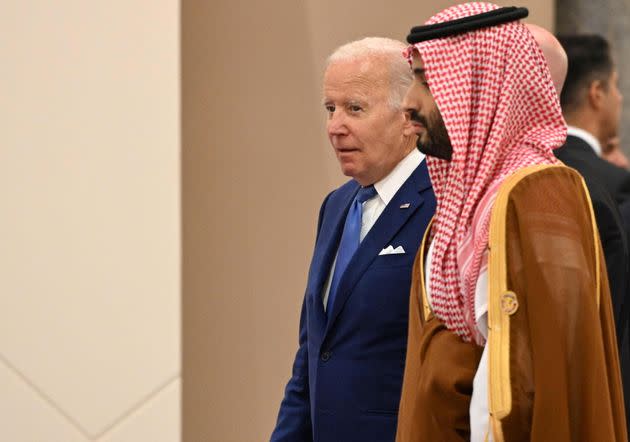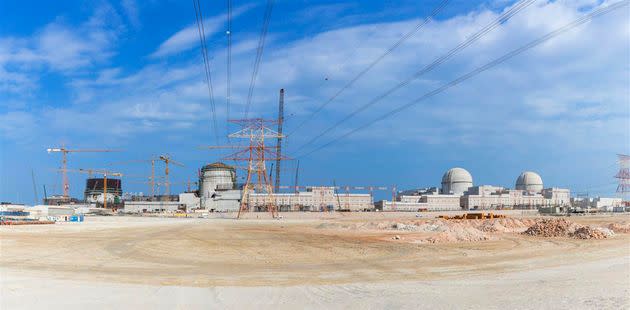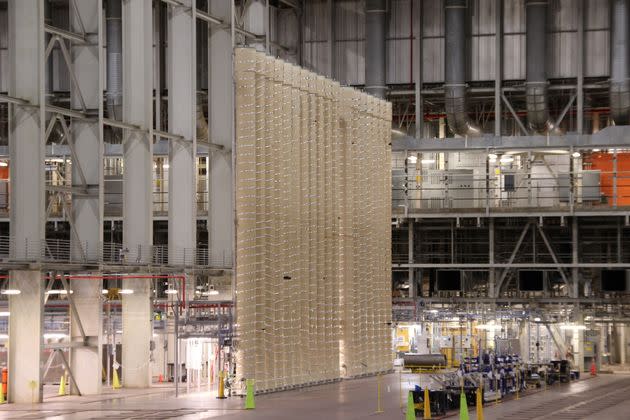Saudi Arabia’s Nuclear Ambitions Have Put The U.S. Into A Bind

President Joe Biden and Saudi Crown Prince Mohammed bin Salman arrive to take a photo during the "GCC+3" (Gulf Cooperation Council) meeting at a hotel in Jeddah, Saudi Arabia, July 16, 2022.
Saudi Arabia’s bid to build its first nuclear energy station is setting up a tough choice for the United States: relax a Cold War-era policy designed to prevent the proliferation of atomic weapons, or risk pushing one of the world’s most powerful energy exporters further into China’s orbit.
It’s a question that could dictate how quickly the global economy breaks its addiction to planet-heating fossil fuels and alter the balance of power in a region that has long defined Washington’s foreign policy. But this pivot point also raises questions about whether the U.S. — which has struggled to keep atomic energy going at home, much less construct new reactors — should still command such sway over other nations’ nuclear energy ambitions.
Since 1968, the Treaty on the Non-Proliferation of Nuclear Weapons has set the ground rules for countries seeking to harness the awesome power released when uranium atoms split apart, barring the production of the most deadly materials used in bombs but still allowing nations to enrich, split and recycle their own uranium fuel. But the U.S. has required countries that want its help building nuclear reactors to go even further, signing on to what’s known as a 123 Agreement, a pact granting Washington even more control over how radioactive isotopes are used. The agreements, forged by the State Department and, like a treaty, subject to Senate confirmation, were created to encourage the use of atomic energy without raising the risk that facilities meant to enrich or reprocess uranium for reactor fuels might be misused to produce plutonium for weapons.
In recent years, the U.S. has promoted what it calls “gold standard” agreements, in which the partner country promises to never enrich or reprocess its own fuel. In exchange for signing on to the first such a deal in 2008, Washington gave its blessing to the United Arab Emirates’ debut nuclear plant, which the oil-rich kingdom plans to tout in November when it hosts this year’s United Nations climate summit in Dubai.

This undated photograph, released by the United Arab Emirates' state-run WAM news agency, shows the under-construction Barakah nuclear power plant in Abu Dhabi's Western desert.
Saudi Arabia began talks with the U.S. over the past year in which Riyadh opened the door to establishing diplomatic relations with Israel as part of a deal for nuclear energy. But last week, following an August summit of developing countries, The Wall Street Journal reported that Saudi Arabia, the world’s No. 2 exporter of oil behind the U.S., was now considering an offer from China to build its debut reactors instead, with potentially far fewer strings attached. The Financial Times confirmed the claims in a report published a day later.
HuffPost could not independently verify the Saudi-Chinese talks. But there are clear advantages to working with Beijing. China has competently expanded its own nuclear power fleet at home, beating the U.S. at building a signature new American reactor design four times over in the past few years. While China’s reactor construction has been focused at home, Beijing maintains strong ties with Russia, the No. 1 nuclear exporter and top source of enriched uranium worldwide. And, perhaps most relevant, China is not expected to require Saudi Arabia, a country that owes its vast wealth and geopolitical influence to its energy exports, to forswear developing its own domestic industry to mine, enrich and recycle reactor fuel.
Washington’s policy is “still operating from this perspective” that if the U.S. doesn’t help build a country’s first nuclear reactor, it simply won’t happen, said Jessica Lovering, the executive director of the Good Energy Collective, a progressive pro-nuclear group.
“Slowly the U.S. is realizing there are other options on the market,” she said. “Saying, ‘if you don’t forswear enrichment, we won’t partner with you’ doesn’t have the same stick approach that it used to.”
When President Dwight Eisenhower pledged to unite the world in pursuit of abundant nuclear energy as part of his “Atoms for Peace” speech in 1953, the U.S. was building more mining and enriching more uranium, and building more reactors, than any other nation.
Those days are gone. The U.S. imports 95% of the uranium to fuel its fleet of reactors that, while still the largest in the world, has been on steady decline for decades. The only new type of commercial reactor built in the U.S. in a generation, the infamously delayed Plant Vogtle project in Georgia, went billions over budget, and is only just now coming online years late. And while other nations recycle spent fuel or bury radioactive waste in repositories meant to keep it safely stored for millennia, U.S. efforts remain in a state of perpetual legal limbo that even pro-nuclear lawmakers seem unwilling or uninterested in confronting.
The great atomic atrophying of the last few decades was hardly an American disease.
In France, which generates most of its electricity from fission, Électricité de France’s fleet fell into disrepair, prompting Paris to bring the national utility back under government control last October as maintenance issues disabled more than half its 56 reactors all at once.
In South Korea, which emerged as the democratic world’s dominant atomic exporter over the past decade, a vehemently anti-nuclear government sought to quash the industry, only to be stopped when a new pro-nuclear president took office.
The State Department is generally stuck in an era where the United States was the dominant commercial nuclear force in the world. And it’s not.Jack Spencer, senior researcher at the Heritage Foundation
Japan halted its 33 reactors in the wake of the 2011 Fukushima disaster, only to scramble to turn them back on as the price of the fossil fuels that replaced the nuclear output soared alongside the country’s greenhouse gas emissions. Germany, which set about shutting down its world-renowned nuclear industry after Fukushima, closed its final reactors in April, triggering a panic among manufacturers struggling for reliable electricity and causing politicians who once supported the phaseout almost immediate regret.
In Russia, by contrast, the state-owned Rosatom charged ahead with building reactors all over the world and rolling out new designs at home. Of the nearly 60 reactors currently under construction in 15 countries — including first-time nuclear users such as Bangladesh, Egypt and Turkey — roughly a third are Russian designs.
Another third are Chinese, primarily being built in China.
By the time the U.S. finally built its first AP-1000 — its only completely new reactor in decades, a next-generation machine designed by the Pittsburgh-based Westinghouse Electric Company in the early 2000s to be the flagship of an American nuclear renaissance — China built four. Beijing now aims to “go global” selling its technologies to other countries, and already has deals with would-be nuclear newcomers such as Sudan and Kenya.
“The State Department is generally stuck in an era where the United States was the dominant commercial nuclear force in the world,” said Jack Spencer, a senior researcher who studies 123 Agreements at the conservative Heritage Foundation. “And it’s not.”
The U.S. is showing signs it wants to compete again. Recent legislation has poured billions of dollars into nuclear development again, including with small or advanced reactor designs that have yet to be commercialized.
With the Vogtle plant finally nearing completion, the newly reconstituted Westinghouse — still headquartered in Pennsylvania but co-owned by a Canadian uranium miner and a Bermuda-based private equity giant led by the former Bank of England governor — is making deals to build AP-1000 reactors in Poland and Ukraine and provide countries like Slovakia with fuel for Russian-designed plants.
But a country like Saudi Arabia, which does not have any nuclear power facilities, faces steeper challenges.
The U.S. began requiring 123 Agreements in the late 1970s after India, which did not agree to the global pact, became the first country after most of the world signed on to the Treaty on the Non-Proliferation of Nuclear Weapons to develop atomic weapons. The even more restrictive “gold standard” came in response to the UAE’s request, and was designed to maintain tight U.S. control over nuclear technology in the Middle East.

An array of centrifuges, known as a "cascade," is shown at Centrus Energy's Ohio facility. The company aims to start producing a rare type of nuclear fuel that only Russia sells on the global market by next year.
While the UAE was eager for the U.S. stamp of approval, it wasn’t even because the Gulf kingdom wanted American technology; South Korea built and designed its debut Barakah Nuclear Energy Plant, but the process required using some U.S. components. Still, the government in Abu Dhabi agreed to forgo enrichment or reprocessing of nuclear fuel on the condition that any neighboring countries would be held to the same standard.
U.S. restrictions on nuclear energy exports are “not a legal standard,” Lovering said. Signatories to the global non-proliferation treaty agree not to build weapons, but the pact allows for the peaceful development of enrichment and fuel recycling.
“It’s more of a norm,” she said.
“I understand the desire from a non-proliferation perspective to want to constrain who does enrichment,” Lovering added. “But it’s also this terrible double standard, where countries that already have nuclear weapons get to do all the enrichment they want, or countries like Japan, which doesn’t have nuclear weapons but is a very wealthy former imperial country, can do what it wants because it’s allied with us.”
Given that the U.S. can hardly muster the political will to maintain its own nuclear fleet, waiting for the American Congress and president to sign off on building reactors in other countries “slows down global nuclear development to a rate that is untenable,” said Daniel Chen, a Taiwanese nuclear engineer and advocate. He laments his country’s decision in 2014 to enter into a uniquely “indefinite” gold standard deal with the U.S., which he said renders one of Taiwan’s best tools for maintaining its de facto sovereignty from China a liability that subjugates the self-governing island to Washington.
“It is basically a breach of sovereignty of a kind that doesn’t exist for other energy sources,” Chen said.
If the U.S. wants to stop other countries from getting the bomb, making its own nuclear industry the obvious choice for newcomer nations is the only way to prevent simply going to one of Washington’s geopolitical rivals, which do not require signing on to the same kinds of strict pacts.
“When one supplier basically requires a much stricter nonproliferation standard than everyone else, it’s disadvantageous, so they end up losing business. When they lose business, they lose the nonproliferation influence,” said Dan Poneman, a former U.S. nuclear regulator and Obama-era Energy Department deputy secretary who now runs the Ohio-based uranium enrichment company Centrus Energy. “If there’s no business, it doesn’t matter what’s in the 123 Agreement.”
To put it more simply, he boiled it down to four words: “No export, no influence.”
